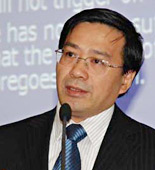|
 |
|
Han Jun, Director of the Research Department of Rural Economy of the Development Research Center under the State Council and one of the compilers of the No.1 Document for 2010 |
By pledging to prop up rural development, the No. 1 Document has indicated a bright prospect for the rural economy. Among the many measures included in the document, one stands out: improving the income and other social benefits for farmers.
Per-capita net income of farmers has increased more than 6 percent for five straight years, but is still well below that of gross domestic product. This has evidently weighed down the purchasing power of farmers and cast an ominous shadow over the rural consumer market.
However, boosting farmers' wealth is easier said than done. The country's annual grain output has exceeded 500 million tons for years, which has kept grain prices at dismal levels. Besides this, the earnings growth of migrant workers has lagged far behind that of urban residents.
But the good news is that faster wage growth for migrant workers may be on the way, as the labor surplus of the country seems to be running low. Late last year, many exporters in coastal areas even experienced acute labor shortages as they geared up to fill rebounding orders in the run-up to Christmas. It is an inevitable trend that employers will have to pay more for skilled migrant workers.
For the government, it is necessary to distribute heavier subsidies for farming and at the same time streamline the compensation systems for migrant workers and protect their deserved rights and benefits. It would also be helpful to reinforce their vocational training and increase the value of rural labor. | 